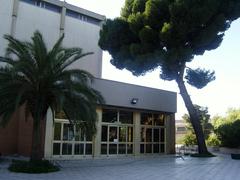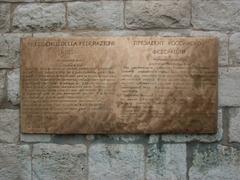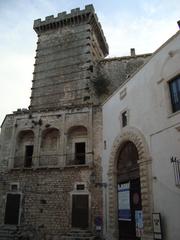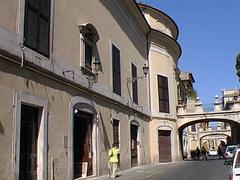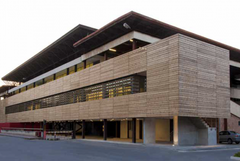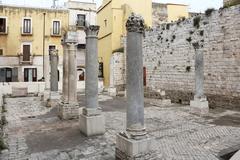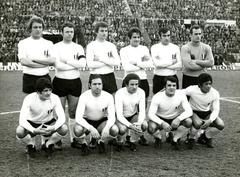Orthodox Church of Saint Nicholas, Bari, Italy: Visiting Hours, Tickets, and Historical Significance
Date: 04/07/2025
Introduction
The Orthodox Church of Saint Nicholas in Bari, Italy—most widely recognized as the Basilica di San Nicola—stands as a monumental symbol of religious devotion, cultural convergence, and architectural splendor. Since its foundation in the late 11th century, the basilica has attracted pilgrims and history enthusiasts from across the globe, serving as a powerful bridge between Eastern Orthodoxy and Western Christianity. This guide explores the basilica’s rich history, Orthodox significance, architectural highlights, visitor information, and broader cultural context, including the Russian Orthodox Church of Saint Nicholas in Bari’s Carrassi district. Whether you are planning a pilgrimage, a historical tour, or a cultural adventure, this article will help you make the most of your visit to one of Italy’s most treasured sacred landmarks. (Wikipedia; St. Nicholas Center; Puglia Guys)
Table of Contents
- Introduction
- Historical Overview
- Architectural and Artistic Heritage
- Orthodox Significance and Pilgrimage
- Ecumenical Role and Modern Orthodox Community
- Rituals and Relics
- Visiting Hours, Tickets, and Visitor Information
- Major Festivals and Events
- Nearby Attractions and Dining
- Russian Orthodox Church of Saint Nicholas: Visitor Guide
- Frequently Asked Questions (FAQ)
- Conclusion
- References
Historical Overview
The Basilica di San Nicola was built between 1087 and 1197, following the dramatic relocation of Saint Nicholas’s relics from Myra (present-day Demre, Turkey) to Bari. This transfer, orchestrated by Bari sailors to protect the saint’s remains from desecration following the Seljuk conquest, elevated Bari as a major pilgrimage destination and a focal point of Christian unity, especially after the Great Schism of 1054. The crypt, specifically constructed to enshrine the relics, was consecrated by Pope Urban II in 1089, while the basilica’s completion in 1197 solidified its status as a spiritual and architectural landmark. (Wikipedia; St. Nicholas Center; Pilgrimaps)
Architectural and Artistic Heritage
The basilica exemplifies Apulian Romanesque architecture, featuring a fortress-like exterior, twin towers, and thick defensive walls. Inside, visitors find a harmonious blend of Romanesque and Byzantine elements: a grand nave with granite columns, an elevated presbytery, and a crypt supported by 26 columns with mixed capitals. The oldest regional ciborium crowns the altar, while the cathedra for Archbishop Elias and mosaic pavements remain highlights of medieval craftsmanship. Notable artistic treasures include the Renaissance tomb of Bona Sforza, Queen of Poland, and twelfth-century silver candelabras. (Wikipedia; Italien Expert)
Orthodox Significance and Pilgrimage
While the basilica is a Catholic church, its spiritual significance to Orthodox Christians is profound. Saint Nicholas is revered across Orthodox, Catholic, and even Protestant traditions. An Orthodox chapel was installed in the crypt in 1966, and the basilica regularly hosts Orthodox liturgies, especially during the principal feast days—December 6 (Gregorian), December 19 (Julian), and May 9 (Translation of the Relics). These events draw thousands of pilgrims from Greece, Russia, the Balkans, and the Middle East, who come to venerate the relics and participate in centuries-old rituals. (Lives of the Saints Calendar; Pilgrimaps)
Ecumenical Role and Modern Orthodox Community
The basilica is a living symbol of ecumenism, hosting historic meetings aimed at Christian unity—including the 2018 gathering called by Pope Francis for peace in the Middle East. Bari’s Orthodox community is active, and services are routinely celebrated in Greek, Russian, and Romanian. The city’s role as a spiritual crossroads is further evidenced by its hospitality to pilgrims and the presence of the Russian Orthodox Church of Saint Nicholas in the Carrassi district. (St. Nicholas Center; Lives of the Saints Calendar)
Rituals and Relics
Saint Nicholas’s relics remain the spiritual heart of the basilica. Annually, clergy extract a small amount of “manna”—a fragrant substance believed to have healing properties—from the saint’s tomb. This ritual, especially revered by Orthodox pilgrims, is central to the annual May 9 festivities and underscores the enduring sanctity of the basilica. Numerous miracles and acts of intercession are attributed to the relics and the manna. (Wikipedia)
Visiting Hours, Tickets, and Visitor Information
Opening Hours:
- Generally open daily from 7:00 AM to 8:30 PM (hours may vary on holidays and during special events).
Admission:
- Entry to the basilica is free.
- Museum and special exhibitions may require a ticket (€3–5).
- Guided tours are available through local agencies and recommended for deeper insight.
Dress Code:
- Shoulders and knees must be covered.
- Modest attire is required for both men and women; a light scarf or shawl is useful in summer.
Photography:
- Permitted in main areas without flash; prohibited during services and in the crypt/Orthodox chapel.
Accessibility:
- Wheelchair accessible with ramps and assistance available.
- Some crypt areas may have limited access.
Best Times to Visit:
- Early mornings for quiet reflection.
- During major festivals (December 6, May 9) for cultural immersion, but expect crowds.
- April, September, and October offer mild weather and fewer tourists.
Location:
- Largo Abate Elia, 70122 Bari, in Bari Vecchia (old town).
- Easily reached on foot from Bari Centrale train station; limited parking nearby.
(Italien Expert; Spotting History)
Major Festivals and Events
- Feast of Saint Nicholas (December 6):
Bari’s most important religious holiday, featuring Mass, processions, and gift-giving traditions inspired by the saint’s legendary generosity. - Translation of the Relics (May 7–9):
Commemorates the arrival of Saint Nicholas’s relics in Bari with historical reenactments, processions, extraction of manna, and city-wide celebrations.
(Office Holidays; Visit Italy)
Nearby Attractions and Dining
Bari’s old town offers a wealth of historical sites, including the Norman-Swabian Castle, Bari Cathedral, and picturesque streets lined with cafes and restaurants serving traditional Apulian cuisine. The proximity of these sites makes it easy to plan a full day of cultural exploration.
Russian Orthodox Church of Saint Nicholas: Visitor Guide
Located in the Carrassi district, the Russian Orthodox Church of Saint Nicholas (Chiesa Ortodossa Russa di San Nicola) is a vital site for Orthodox pilgrims, especially those from Russia and Eastern Europe. Built in the early 20th century in the rare Pskov-Novgorod architectural style, the church features a serene interior adorned with icons and traditional decor. Regular Orthodox liturgies are celebrated, with major events on December 6 and May 9.
Visiting Hours:
- Open daily; hours may vary during religious services and feast days.
- Entry is free, donations welcome.
- Confirm hours via the church’s website or local tourist information offices.
Visitor Tips:
- Modest attire required; women may bring a headscarf.
- Photography is allowed without flash, but be discreet during services.
- Pilgrim house and basic amenities are available; nearby cafes and shops in Carrassi.
(Bariexperience.com; Wikipedia)
Frequently Asked Questions (FAQ)
Q: Are there entrance fees for the Basilica di San Nicola?
A: Entry to the basilica is free; museum and guided tours may have a small fee.
Q: What are the basilica’s visiting hours?
A: Typically daily from 7:00 AM to 8:30 PM, but check for holiday variations.
Q: Is the basilica accessible for people with disabilities?
A: Yes, with ramps and assistance available.
Q: Can I attend Orthodox liturgies at the basilica?
A: Yes, especially during major feast days.
Q: How can I get to the Basilica di San Nicola?
A: Located in Bari Vecchia, a short walk from Bari Centrale station.
Q: What is special about the Russian Orthodox Church of Saint Nicholas?
A: It serves as Bari’s main Orthodox parish, with unique architecture and a focus on Russian and Eastern European pilgrims.
Conclusion
The Basilica di San Nicola and the Russian Orthodox Church of Saint Nicholas together form the spiritual heart of Bari, embodying its identity as a crossroads of faiths and cultures. From the veneration of Saint Nicholas’s relics to the vibrant festivals and the living traditions of both Catholic and Orthodox communities, Bari offers a unique and enriching experience for every visitor.
Whether you come for pilgrimage, history, or cultural exploration, be sure to plan ahead—review visiting hours, dress codes, and local customs—and take full advantage of guided tours and mobile resources like the Audiala app for an enhanced journey.
References
- Basilica of Saint Nicholas, Bari, Wikipedia, 2024
- Who is St. Nicholas? Saint in Bari, St. Nicholas Center, 2024
- San Nicola Festival Bari, Puglia Guys, 2024
- Basilica di San Nicola in Bari, Italien Expert, 2024
- Feast of St Nicholas, Bari, Office Holidays, 2024
- Basilica of Saint Nicholas, Spotting History, 2024
- Russian Orthodox Church of Saint Nicholas, Bari, Wikipedia, 2024
- Russian Orthodox Church of Saint Nicholas, Bari, Bariexperience.com, 2024
